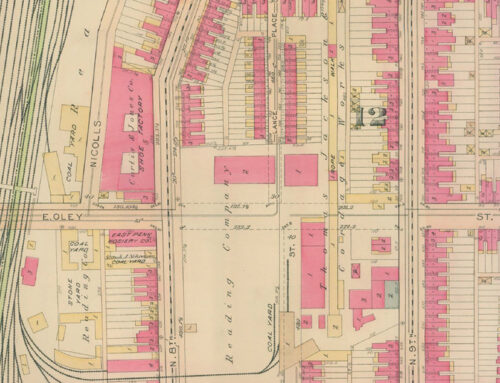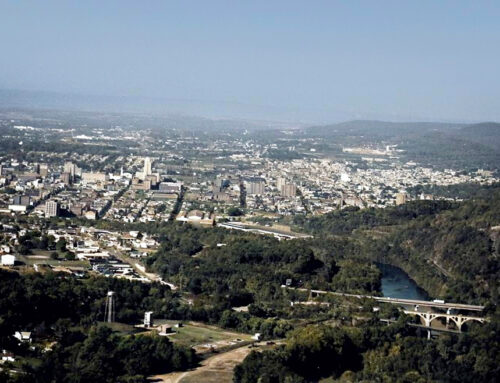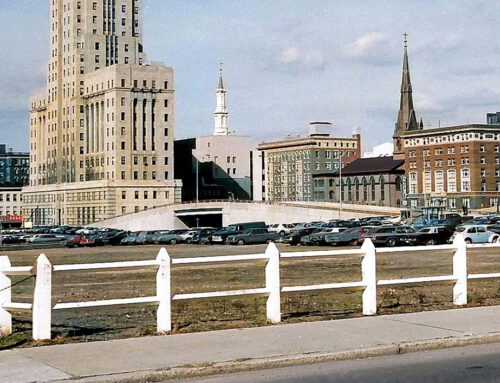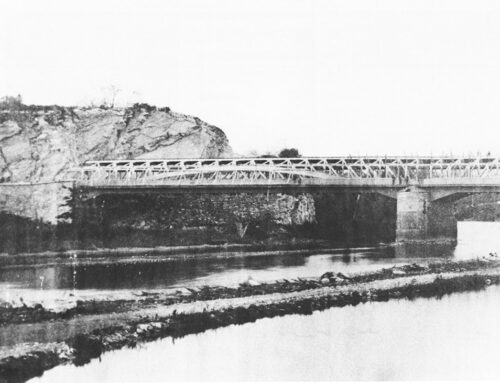Muhlenberg Township had two covered bridges, Stoudt’s Ferry Bridge and Leize’s Bridge, both of which spanned the Schuylkill River and both shared with Bern Township. Bridges were covered only to extend the life of the wooden superstructures but Stoudt’s Ferry Bridge was unique in design.
Stout’s Ferry Bridge (original spelling) was built to replace a ferry operation conducted by the Stout family for many years after the completion of the Schuylkill Navigation System in 1825. The roped-controlled ferry was located at a narrow point on Felix Pool (approximately two miles north of Felix Dam) where the canal towpath changed from the west side (Bern Township) to the east side, now Muhlenberg Township. The ferry was a cumbersome arrangement that entailed loading the tow animals, as many as three to a team, onto a small barge, dragging the boat’s tow line along, manually pulling the ferry across and then off-loading the animals on the opposite towpath. As canal boat traffic increased, this became a time-consuming bottleneck.
Below: Stoudt’s Ferry Bridge looking upstream (northward).

The actual architect of the bridge is unknown, but it was a modified Burr-Truss style with a cantilevered walkway on each side designed in such a way as to allow the tow animals to traverse the bridge in either direction without unhitching from the boat being towed. It was the first transportation “clover-leaf” ever built that is recorded anywhere. It had to be built without any middle piers because they would have prevented the crossing concept and thus it became the second longest (at 225 feet) single-span covered bridge ever built. This was the only major covered bridge in the United States built for this purpose.
Below: Stoudt’s Ferry Bridge approaching from Bern Township in the mid-1940s.

Below: Stoudt’s Ferry Bridge showing cantilevered outer walkway for mules on right.

The bridge was built by a corporation headed by Jacob Stout and thirty-three other “commissioners.” Stock was sold for twenty-five dollars a share, with a maximum capitalization of ten thousand dollars. The company was incorporated in May of 1855 and construction started in 1856. Despite a damaging storm in 1857, it was completed in July 1857. The total cost, including a stone tollhouse on the Bern side (still standing) and a forty-foot open bridge on the Muhlenberg side, was $9700. Typical tolls were one cent for a foot passenger and three cents for every horse or mule.
While there was a very handsome stone house next to the bridge for the toll collector to live in, during the hot summer months the toll collector slept on the bridge. There was a fold down bed on the bridge in which the toll collector slept. Under the bed was a wooden box in which his watchdog lived. Next to the bed there was a small workbench on which small repairs could be made on the bridge. Next to the workbench was a gaslight and a cabinet containing carpenter tools. The toll collector received $30 dollars a month plus the use of the tollhouse (or a bed on the bridge in the summer if so desired). Tolls continued to be charged until June 9, 1890, at which time the court declared the bridge to be free of tolls.
On June 10, 1909 the 40-foot wooden approach span constituting the Muhlenberg approach to Stoudt’s Ferry Covered Bridge collapsed. Cyrus and George Roth, brothers, narrowly escaped with their lives. The two men were hauling a load of manure across the structure when it broke down. The four horses hitched to the wagon, the vehicle, and the men were precipitated to the roadbed leading to Charles Durell’s farm, 20 feet below. The approach bridge was rebuilt shortly thereafter.
Below: Stoudt’s Ferry Bridge entrance in the early 1940s showing the towpath, the short bridge approach from the Muhlenberg side, and the tollhouse on the Bern Township side.

After the canal ceased operations in the 1920’s, Stoudt’s Ferry Bridge was no longer used for its original purpose and fell into a general state of disrepair. By 1945 it was proposed that the state take possession of the bridge and repair and preserve this historic span. Unfortunately the transfer and repair never took place before the bridge collapsed on the silt-laden river on September 12, 1948.
Allegedly, a heavy truck, far in excess of the posted 1 1/2-ton limit, passed through the bridge on Friday, Sept. 10. Later the same day those strange noises became louder, prompting Muhlenberg Township authorities to close the road leading to the bridge to vehicular traffic. There are those who believe the collapse was accelerated by the assistance of the out-of-state dredging contractor. The bridge had stood in the way of the expedient dredging process which had begun at that point.
Below: Looking eastward to the Muhlenberg Twp. side, Mon., Sept. 13, 1948.

About 75 feet of the eastern end remained intact, although it sloped sharply from the anchoring abutment. The remainder of the structure was resting in a mass of broken timbers, half of it on the culm (coal dirt) that clogged the river at that point and half in the open water flowing by on the Bern Township side.
Authorities first planned to burn the remains as the quickest and cheapest way to expedite the cleanup operation. In the end, Paul J. Zipp of Dauberville was given a contract for removal of the bridge – based on his bid of $301 – which eight men accomplished within the 10-day time limit agreed upon.
The salvaging process netted Zipp 100,000 feet of lumber. Of this amount, 70,000 feet of “greatly seasoned” white pine went to a Lancaster County cabinet-making firm. Zipp also recovered about 20,000 feet of oak planking that had been used as the floor.
Stoudt’s Ferry Bridge passed from the scene – a victim of neglect and the public’s lack of awareness and appreciation for its extraordinary historic worth and uniqueness.
Except for a numerically insignificant group of enlightened people, the post-war mentality wasn’t attuned to the responsibility for preservation and restoration of irreplaceable landmarks for generations yet unborn.
If Stout’s Ferry Bridge was still standing, there is little doubt it would be one of the major attractions of the county and very possibly of the state.






Leave A Comment